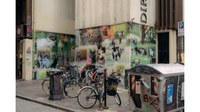PUBLIC ART PROJECT / Phase 1 - 2024
TANGLE - Visual culture in urban art

The Department of Management promoted a public art project conceived by Parsec in collaboration with Andrea Gianfanti, for the space in front of the entrance to its headquarters at 34 Via Capo di Lucca in Bologna.
The project concerns 3 artistic interventions to propose a dialogue between the public space and the people who cross it, stimulating continuous and active participation and a reflection on the images.
The intent is to listen, evaluate, and understand - through ethnographic observations and analysis - the relationship that is created between the interventions presented and the different possible forms of creative interaction. Therefore, a site-specific intervention intended to open a dialogue on the perception, reaction, and re-manipulation of images today.
We reflect on three different types of images, but equally present in our everyday lives:
- the cute of the post-internet era
- the anthropocentric representation of climate change
- the search, through play, for parallel realities.
The cute in the post-internet age.
The first intervention involves images of kittens. Especially thanks to social networks, memes, stickers, and emoji, cats, like other animals, are images to which we are often subjected in our daily lives and which cause us a temporary sense of comfort and lightness that fits well among the anxiety and constant worries to which we are constantly subjected. The cute can easily mix with the grotesque and the disturbing, making its manifestations often destabilizing. Therefore, the purpose of this intervention is to reflect on the various implications of cuteness, observing the interaction that the images of kittens may suggest.
Aesthetization of the Anthropocene: how the pollution problem of the Po Valley becomes an abstraction.
The second intervention is an abstract image derived from satellite photographs of what is effectively the largest abstract landscape in Italy: the Po Valley.
The landscape of the Po Valley today has vegetation consisting mainly of cereals, plants for animal feed, raised mainly in an intensive, and fruit trees. It is a landscape in which herbaceous vegetation prevails over trees, similar to a kind of "cereal steppe," a man-made environment, very different from the pre-existing natural environment. During its expansion, dense forests consist of trees of different species. With the economic and social recovery of the area, definitive deforestation began, accompanied by massive and incessant building of the territory.
By the 19th century, nothing had remained of the ancient forest, and the landscape was now artificial, not too dissimilar to how it is seen today. Today, there are very rare patches of the original forest cover: what can be observed is the largest artificial landscape in Italy.
The intent of this intervention is to question the visual culture of the landscape and the climate crisis today. The intervention suggests paying attention to the only figurative details of this abstract landscape: the indicators of Google Maps, which identify only farms, factories, grain, gas pumps, and tourism gastronomy.
We question ourselves, therefore, proposing two satellite images of our territory but suggesting a possibility of interaction through specific placeholders, revisited critically to highlight the impact of the main authors of the proposed image.
Public art and Community: how play can subvert the space
The third intervention was entrusted to Mexican artist Tiz Creel, who, by proposing three different wall games, intends to activate public space by stimulating the creation of new imaginaries and parallel realities.
Starting from traditional elements of our game-related visual culture, the artist proposes their transformation and subversion, revisiting them with iconic images of the city of Bologna.
Life is like a goose game; there is a time to throw and a time to pick up. Time becomes an illusion, and fiction actually creates a new reality.
For Creel, anyone can play at any time. According to Creel, play helps us pursue a higher interest in the things around us: when we play, we fully engage with life and its contents to discover deeper truths in ordinary things.
The intent is precisely to create a utopian community that can reclaim space.... what if we took time to look at each other, be together, and make a community?
All three interventions and the multiple interactions that resulted have been constantly observed and documented and will go on to compose a publication, which will be presented at the end of the project. With this intervention, its creators and the Department of Management intend to promote relations and confrontation with the relevant urban context, with a view to interaction and collaboration.